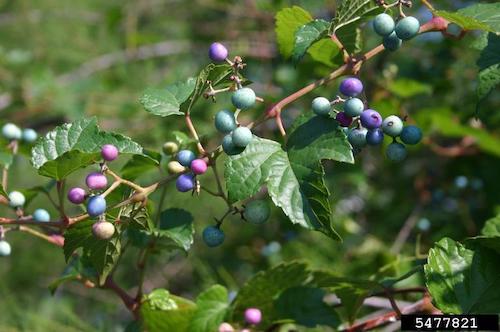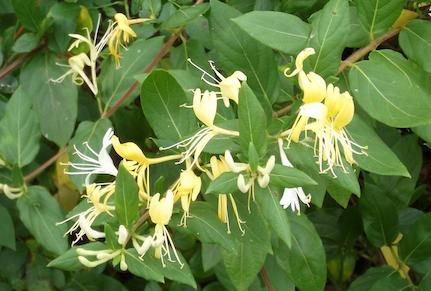Removal of Opportunist and Invasive Vines
by Carolyn Casey, Fairfax Master Gardener

Porcelain berry
You can protect the trees and shrubs in your yard and our community by becoming familiar with native opportunistic and non-native invasive vines that pose a significant risk of suffocation and death to these plants. Because of the degree of risk, you may want to call a professional for help in removing these vines. Being able to identify them and learning how to remove them is the key to maintaining a healthy environment. Below are common native opportunistic and non-native invasive vines in our area. Never compost these vines or dispose of them in landfills.
Poison ivy (Toxicodendron radicans) is native and blankets the ground and climbs trees. Poison ivy leaves are three green leaflets with a reddish center and may be smooth, wavy, lobed or toothed. It has clusters of white waxy fruit. Poison ivy grows quickly and propagates itself by underground rhizomes and seeds. It attaches itself to trees and structures with hairy aerial roots that are on the stem. Poison ivy starts in the landscape from seeds dropped by birds and quickly becomes a widespread problem. It grows in shrubs, trees and groundcovers making it difficult to control. Small infestations of poison ivy can be dug up. Repeated cutting depletes root resources and eventually eliminates sprouting. Herbicides should be applied two weeks before and two weeks after full bloom. Please read the label before applying herbicides: the label is the law. While working with poison ivy, wear long sleeves, pants and gloves. Wash your clothes in a urushiol removing formula. Use Ivy Block to protect your skin and degreasers like Tecnu and Zanfel to remove oils from the skin.
English ivy (Hedera helix) is a non-native, evergreen vine that grows up to 90 feet tall and 10 inches in diameter. It is invasive in 18 states, including Virginia. The new growth is light green, and older growth is dark green with white veins. It climbs anything that provides support. Growing on the ground, it shades out seedlings and herbs. In trees, it engulfs branches, shading and slowly killing them. It topples trees in the wind, snow or ice. It is a reservoir for bacterial leaf scorch, a disease that affects maples, oaks and elms. English ivy damages trees and shrubs, competing for water, nutrients and light. It holds moisture and serves as a pathway for insects and other pests. It produces toxic berries that birds eat and drop, allowing for more plants to be produced. Any rooted piece can resprout. English ivy’s waxy leaves repel herbicides and makes it necessary to use spreader sticker. Herbicides must be applied in high concentrations. Cut ivy vines near the ground and then again at approximately eye-level to make a vine-free band around the tree trunk. Carefully remove the cuttings so no damage is done to tree bark. These cuttings will try to root, so dry them thoroughly. Do not pull the remaining ivy off trees as it may take the bark with it. Severed ivy left on trees will die and eventually fall off. Remove ivy from the ground at least 2 to 3 feet (0.6 – 1 m) around the base of tree. If necessary, follow vine cutting with application of concentrated systemic herbicide to rooted, living cut surfaces.

Japanese honeysuckle
Japanese honeysuckle vine (Lonicera japonica) is highly invasive, non-native evergreen to semi-evergreen and creates dense monocultures on the ground. It spirals up trees and shrubs, strangling and killing them by blocking sunlight. It has cream and golden yellow trumpet-shaped flowers. It has berries that are a glossy black that contain 2 to 3 seeds each. It causes weakened trees to fall. Seedlings can be pulled and dug up. It can be cut to the ground and recut at the first appearance of new growth. This starves the root system. It requires persistence. You can also cut down the trunk and paint or target spray the stump within five minutes.
Kudzu (Pueraria montana var. lobata) is non-native, highly invasive and grows a foot a day, reaching 60 feet a season. The root weighs up to 400 pounds. In mid-summer it has hanging clusters of pea-like purple to red flowers. It also has dark brown flattened hairy pods that produce viable seed, and reproduction is mainly vegetative. Thirty shoots may grow from a single crown and root where nodes come in contact with soil. Cutting and mowing are control methods that must be done for two seasons or more. Goats can exhaust the root system by grazing. Herbicides are most effective in early fall.

Mile-a-Minute
Mile-a-minute vine (Polygonum perfoliatum) is non-native and grows 25 feet (7 m) a season. It has dull green triangular leaves with sharp corners. It has barbs that point backward and quickly shade and smother plants. Mile-a-minute vine is easy to pull and dig up since it does not have much of a root system. Remove and bag flowers before seeds form.
Oriental bittersweet (Celastrus orbiculatus) is a non-native vine that engulfs, smothers trees and shrubs and topples them. In the spring it has clusters of pale yellowish-green flowers. It has an orange capsule that is 1/3 of an inch (7 mm) that splits open exposing red seeds. Seedlings can be pulled or dug up. Remove and bag flowers before seeds form.
Porcelain berry (Ampelopsis brevipedunculata) is non-native and climbs over trees and shrubs shading and killing them. It is strangling many trees in Virginia’s wooded areas. This invasive is robbing trees and shrubs of light and threatening to snap branches during ice storms. Because it resembles native grapes, it is easily overlooked. It forms clusters of green to yellow, lavender or bright blue berries. When porcelain berry vines are young, the vines can be pulled. Older ones can be cut and immediately painted with an herbicide. If you skip this step, the vines will resprout.
Chinese and Japanese wisteria (Wisteria sinensis and Wisteria floribunda) are non-native vines that strangle and shade out the foliage of trees and shrubs. It has clusters of beautiful fragrant purple flowers that can be several inches long. It has leaves that are compound and about 1 foot long and has 7 to 13 leaflets on the Chinese wisteria and 13 to 19 on the Japanese wisteria. It has velvety brown seed pods that are 4 to 6 inches long (10 – 15 cm). Cut the vines and bag them making sure that no portion touches the ground. After cutting them to the ground, woody vines must be unwrapped from tree trunks, or they will still girdle trees and shrubs. The vines of Chinese wisteria grow counter-clockwise while Japanese wisteria vines grow clockwise. Recut vines at the appearance of new growth. This starves the root system and requires persistence. Remove and bag flowers before seeds form. The trunk can be cut and then painted, or target spray the vine stump in five minutes.

Virginia creeper
Virginia creeper (Parthenocissus quinquefolia) is a native perennial and aggressive vine in our area, but not always invasive. It is a fast growing, deciduous, vine that may trail along the ground or climb anything since it does not need support to grow. It climbs to a height of more than 50 feet (15 m) with a spread of more than 35 feet (10 m). The leaf is composed of five green leaflets that have tooth edges and are from 2 to 6 inches long (5 – 15 cm). It is often mistaken for poison ivy. When its bark is mature it is gray-brown and aerial roots appear along its surface. When rapidly growing, the aerial roots are bright orange brown. It is found throughout North America. When growing on any tree or shrub it can cover the top with dense foliage that prevents the host plant from receiving sunlight which may kill the plant. It travels from plant to plant. Trees and shrubs can succumb to a canopy of Virginia creeper in just a couple of years if the trees are not strong. Once the vine is established, it is difficult to remove. Young plants can be pulled by hand. In a season or two, the vines will have covered the host plant with a lush canopy. Pull the vines down as much as possible. Follow a vine stem down to the ground and dig it out if possible. Or cut it close to the ground and apply glyphosate on the cut stem.

Trumpet creeper
Trumpet creeper (Campsis radicans) is a native deciduous vine. It climbs by aerial roots and stems can grow from 20 to 40 feet long (6 – 12 m). It has opposite leaves that are pinnately compound with 7 to 15 tooth leaflets. It reproduces by seed, root sprout and stems that root along the ground. It has clusters of orange trumpet shaped flowers followed by 4 to 6 inch (10 – 15 cm) slender seed pods. It can be manually removed by cutting the vines to the ground, keep cutting back all new growth until all energy reserves in the roots are gone. It may take several seasons to eliminate this vine.
General guidance on removing and eradicating vines includes the following: Cut away as much of the vine as possible in 6-inch sections (15 cm). This makes the vines unable to transport nutrients. When cutting the vines away from a tree be careful not to cut the bark or the trunk of the tree. Use pruning shears to clip small vines away from trees. A handsaw may be needed when dealing with larger vines. Wear gloves when dealing with vines to prevent encountering possible oils that may cause skin irritation. Winter is the best time to remove vines. It makes it easier to see and remove and there is less chance of skin irritation. To guard your plants, the best time to remove vines from growing on your plants is when you first notice them. These threatening vines should be removed for the safety of humans, animals and other plants, especially our beautiful trees and shrubs.
References
• Introduction to Invasive Plants in Maryland, Dr. Sara Tangren, University of Maryland Extension
• You ARE FROM Around Here! Opportunistic Species of the Quarter: Poison Ivy, Jennifer Gagnon,
Virginia Tech
• English Ivy, Loudoun County Master Gardeners
• Invasive Vine and Groundcover Control, University of Maryland Extension
• Chinese and Japanese Wisteria, Christa Carignan, University of Maryland Extension
• Parthenocissus quinquefolia, North Carolina Extension Gardener Plant Toolbox